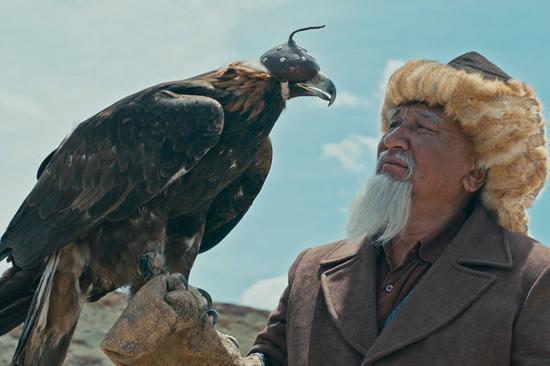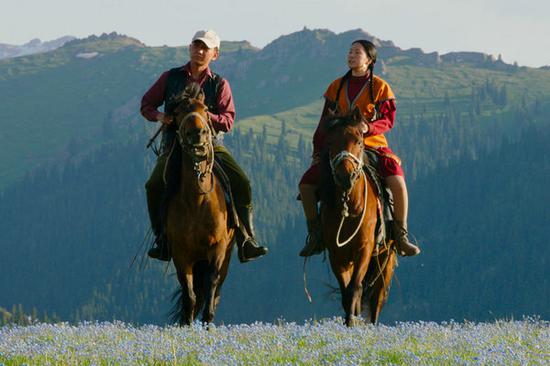
A scene from the film that shows a key character and his falcon. (Photo provided to China Daily)
The owners of herds of sheep, cattle, horses and camels are on their way to another pasture. The trip is filled with cold, hunger, tiredness and danger. And ignorance may lead to loss of property and even life.
This is how the Kazak people migrated in the old days. It was done according to the growth circle of the grass, and to ensure that their livestock had plenty to eat all the year round.
But now, with rising living standards, there are villages for nomadic herders, enabling them to settle down.
Fade Away Pastoral, a feature film focusing on changes in Kazak life-from arduous migration to settlement, premiered in Beijing recently.
"It is a visual feast and reflects the progress on the grassland," says Gao Huanggang, chief producer of the film.

A scene from the film Fade Away Pastoral, a film focusing on the changing life of Kazak people in the Xinjiang autonomous region. (Photo provided to China Daily)
It uses a conflict between the Humar and Hadysha families, as a result of a fatal accident, to showcase the Kazak experience and journey over the past 40 years in China.
Visitors may marvel at the natural beauty of the grasslands where the Kazak live. But for Zhou Jun, the director of the film, "it is the only compensation for the herders' hard lives".
The film, generally speaking, shows both picturesque views and the Kazak herders' lives.
As the saying goes, "The Kazak walk the most in the world, and they migrate the most."
Migration, which was necessary for the Kazak, was a painstaking task as herders had to face bad weather, rough roads and other difficulties on their long journeys, which would often be several hundred kilometers.
From Zhou's perspective, the Kazak are stoic, introverted and profound. "Toughness and fortitude can be found in everyone."

A scene from the film Fade Away Pastoral, a film focusing on the changing life of Kazak people in the Xinjiang autonomous region. (Photo provided to China Daily)
Nowadays, migration in search of pasture only exists in some parts of the Xinjiang autonomous region, and the numbers are decreasing.
Many people choose to migrate by trains or cars, but many decide to settle down.
The ancient way of nomadic migration may disappear in coming times.
"In future, people will know about nomadic migration only from books or videos. So, in a way the film is like an effort to preserve history," says Zhou.
In the past, people on the grasslands said a man lived a good life if he owned a shotgun, a falcon, a horse, a hound and had a woman who loved him.
In the film, a member of the Humar family has already lost his wife. And then as time passes by, he loses his shotgun, horse, hound and falcon.
The losses imply his final farewell to his beloved grassland. And the film also shows herders welcoming a better life while giving up some of their earlier pleasures.

